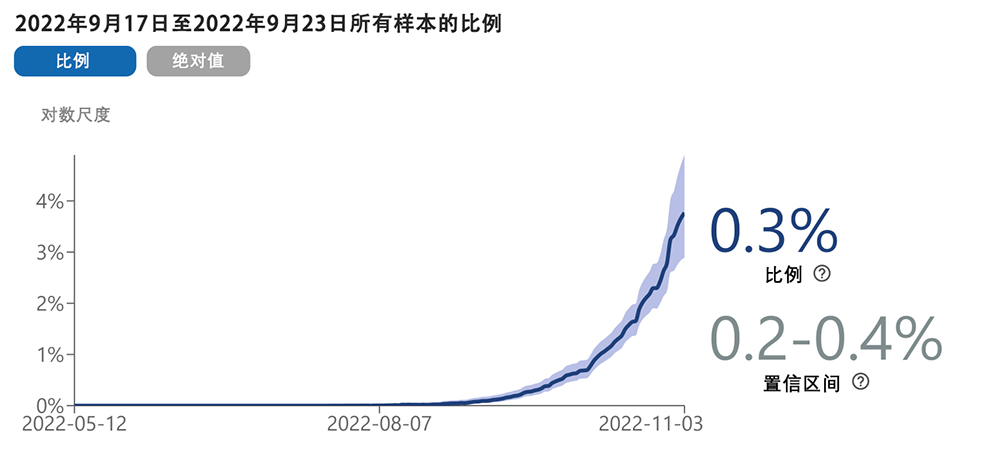
美国疾病控制与预防中心(U.S. Centers for Disease Control and Prevention)于11月11日在其跟踪的新冠变异毒株名单中增加了第16种变异毒株——BN.1。
截至11月12日,这种最新被发现的病毒株预计占美国感染人数的4%以上,成为美国第六种最常见的变异毒株。它的排名甚至高于BA.4.6。BA.4.6是奥密克戎亚变异毒株BA.4的后代,今年夏季成为全球流行的主要病毒株。
对于新冠疫情今年秋季的新成员,我们了解哪些信息?
据cov-lineages.org的数据显示,BN.1也是一种奥密克戎变异毒株,其全称为B.1.1.529.2.75.5.5.1。cov-lineages.org是由英国和澳大利亚的高校的捐赠者运营的新冠数据集。这种新变异毒株也是“隐形奥密克戎”BA.2的后代。BA.2是今年春季和夏季的主要病毒株,在实验室开展的新冠检测中,BA.2会呈现令人迷惑的结果,因而为世人所知。
在众多的新奥密克戎变异毒株里,BN.1的表现,尤其是在众多人口中的表现,仍然是一个未知数。但位于瑞士的巴塞尔大学(University of Basel)的计算机生物学家科尼利厄斯·勒默尔最近写道,BN.1有极高的潜力能够逃脱之前感染和接种疫苗所产生的免疫力。印度的研究人员上周在《Cureus医学杂志》(Cureus Journal of Medical Science)上发表的一篇期刊文章显示,这种变异毒株可以与其他正在传播的同系列变异毒株竞争。
covid-lineages.org的数据显示,到目前为止,今年7月末最先发现的BN.1病例,主要集中在美国、英国、奥地利、澳大利亚和印度。在全世界已经发现的近4,000例感染者中,每个国家各占约15%。
虽然许多人最近才知道BN.1,但它实际上已经繁殖出9种第二代和第三代变异毒株,大部分最早于今年8月和9月被发现。所有变异毒株均在欧洲国家被发现,包括奥地利、英国、丹麦、德国和爱尔兰等。新加坡、韩国、日本以及印度和以色列等亚洲国家也发现了一些变异毒株。

截至11月14日,美国除住院病例以外的新冠感染病例小幅增加,死亡病例的趋势小幅下降。美国新冠确诊病例接近1亿,专家表示由于检测和报告频率下降,这个数字可能被严重低估,美国死亡人数已经超过100万。(财富中文网)
翻译:刘进龙
审校:汪皓
美国疾病控制与预防中心(U.S. Centers for Disease Control and Prevention)于11月11日在其跟踪的新冠变异毒株名单中增加了第16种变异毒株——BN.1。
截至11月12日,这种最新被发现的病毒株预计占美国感染人数的4%以上,成为美国第六种最常见的变异毒株。它的排名甚至高于BA.4.6。BA.4.6是奥密克戎亚变异毒株BA.4的后代,今年夏季成为全球流行的主要病毒株。
对于新冠疫情今年秋季的新成员,我们了解哪些信息?
据cov-lineages.org的数据显示,BN.1也是一种奥密克戎变异毒株,其全称为B.1.1.529.2.75.5.5.1。cov-lineages.org是由英国和澳大利亚的高校的捐赠者运营的新冠数据集。这种新变异毒株也是“隐形奥密克戎”BA.2的后代。BA.2是今年春季和夏季的主要病毒株,在实验室开展的新冠检测中,BA.2会呈现令人迷惑的结果,因而为世人所知。
在众多的新奥密克戎变异毒株里,BN.1的表现,尤其是在众多人口中的表现,仍然是一个未知数。但位于瑞士的巴塞尔大学(University of Basel)的计算机生物学家科尼利厄斯·勒默尔最近写道,BN.1有极高的潜力能够逃脱之前感染和接种疫苗所产生的免疫力。印度的研究人员上周在《Cureus医学杂志》(Cureus Journal of Medical Science)上发表的一篇期刊文章显示,这种变异毒株可以与其他正在传播的同系列变异毒株竞争。
covid-lineages.org的数据显示,到目前为止,今年7月末最先发现的BN.1病例,主要集中在美国、英国、奥地利、澳大利亚和印度。在全世界已经发现的近4,000例感染者中,每个国家各占约15%。
虽然许多人最近才知道BN.1,但它实际上已经繁殖出9种第二代和第三代变异毒株,大部分最早于今年8月和9月被发现。所有变异毒株均在欧洲国家被发现,包括奥地利、英国、丹麦、德国和爱尔兰等。新加坡、韩国、日本以及印度和以色列等亚洲国家也发现了一些变异毒株。
截至11月14日,美国除住院病例以外的新冠感染病例小幅增加,死亡病例的趋势小幅下降。美国新冠确诊病例接近1亿,专家表示由于检测和报告频率下降,这个数字可能被严重低估,美国死亡人数已经超过100万。(财富中文网)
翻译:刘进龙
审校:汪皓
The U.S. Centers for Disease Control and Prevention on November 11 added a 16th variant to the list of those it’s tracking—BN.1.
The newly singled-out strain was estimated to comprise just over 4% of U.S. infections through November 12, making it the sixth most common variant in the country. It came in just above BA.4.6, a descendant of Omicron spawn BA.4, which was prominent globally this summer.
Just what do we know about one of the newer additions to COVID’s autumn “alphabet soup”?
BN.1, also a strain of Omicron, is a shorter name for B.1.1.529.2.75.5.5.1, according to cov-lineages.org, a collection of COVID data run by contributors at universities in the U.K. and Australia. The new variant is also a descendant of “stealth Omicron” BA.2, which became famous for producing confusing results on lab-based COVID tests when it was prominent this spring and summer.
As with so many new Omicron variants, just how the strain might present itself—especially in a large population—is unknown. But BN.1 has a high potential for escaping immunity from previous infection and vaccination, Cornelius Roemer, a computational biologist at the University of Basel in Switzerland, recently wrote. And the variant has the ability to compete with other circulating lineages, according to a journal article published last week in Cureus Journal of Medical Science from researchers in India.
So far, the largest concentrations of BN.1, first identified in late July, have been found in the U.S., the U.K., Austria, Australia, and India, according to covid-lineages.org. Each country is home to about 15% of the nearly 4,000 identified cases throughout the world.
Although new on the radars of many, BN.1 has already spawned nine known child and grandchild variants, most of which were first identified in August and September. All have been identified in European countries like Austria, the U.K., Denmark, Germany, and Ireland. Some have been identified in Asian countries like Singapore, South Korea, and Japan, as well as in India and Israel.
U.S. cases of COVID, in addition to hospitalizations, were ticking slightly upward as of November 14, and deaths were trending slightly downward. The U.S. is nearing 100 million documented cases of COVID, a number experts say is likely a vast underestimate due to the decreased frequency in testing and reporting, and has seen more than 1 million deaths.






